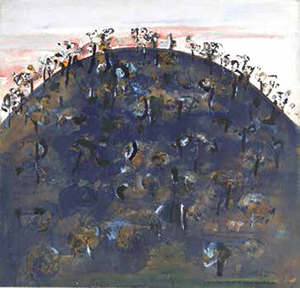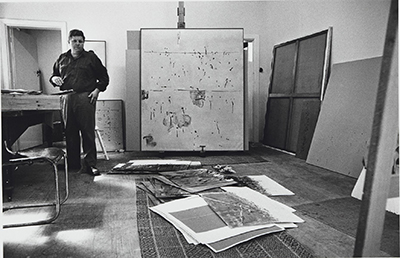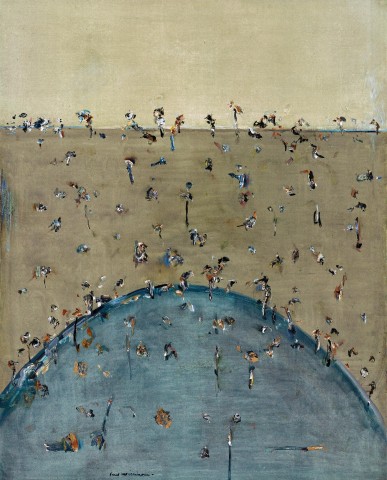HUMMOCK IN LANDSCAPE, 1967
FRED WILLIAMS
oil on canvas
153.0 x 122.0 cm
signed lower centre: Fred Williams
Rudy Komon Gallery, Sydney
James O. Fairfax AC Collection, New South Wales
Private collection, New South Wales, acquired from the above prior to 1976
Fred Williams, Georges Gallery, Melbourne, 25 September – 14 October 1967, cat. 10 (label attached verso)
Hillock, 1965, gouache on ivory Arches paper, 51.7 x 53.8 cm, in the collection of Art Gallery of New South Wales, Sydney
Hummock in a Landscape, 1966 – 67, oil on canvas, 91.0 x 81.0 cm, illus. in McCaughey, P., Fred Williams, Bay Books, London, Sydney, 1980, pl. 91, p. 182
When Fred Williams returned to Australia in late 1957, it was to foreshadow a decade which we now recognise as representing a profound shift in Australian art. After six years in London, which included study at the Chelsea School of Art,1 his art steadily synthesised into an entirely original expression that reached its height by the late sixties. It was a time in which critical, commercial and institutional respect converged and spoke of Williams’ authority as a significant Australian painter and printmaker.
FRED WILLIAMS (1927 – 1982).jpg

National myth and hero painting had all but run its course. Interest in abstraction was healthy, and some wondered about the future of landscape painting offering anything fresh and important. Williams became its masterful exponent, where the landscape was his wellspring and it would reassure us this genre could create great and enduring art.
Williams was an artist with a deep understanding of art history. He was equally curious about younger Australian artists whose interest in new abstraction was creating considerable interest. Their flat Colour field abstraction would be shown in The Field exhibition, part of the opening celebrations for the National Gallery Victoria’s new home on St Kilda Road in 1968. These artists admired Williams’ work and enjoyed his company.2 When we consider his work from the late sixties this reciprocal interest and respect becomes self-explanatory. In the publication accompanying the National Gallery of Australia’s major exhibition Fred Williams: Infinite Horizons, a chapter is given to his work from the 1960s: Classic Williams.3
Early after his return to Australia, Williams painted at places such as Mittagong, New South Wales, Sherbrooke near the Dandenong Ranges, and northern Victoria. In 1962 he and his wife, Lyn, moved to Upwey. The location and surrounding areas were an endless source for work that followed. The motif itself was always the essential and lasting impetus for his art. Painting and sketching en plein air and the isolation of his studio were of corresponding importance. The keenness and adaption of his observation on location and making art within the introspective space of his studio were inseparable in his working method.
In Hummock in Landscape, 1967 we find a brilliant aggregate of these two distinctive elements – the landscape observed and a studio confidence, where simple forms and pictorial elements become boldly complete. There is nothing timid or cautiously experimental happening. Its clarity of purpose and surface resolution stand out. It was painted shortly after he won the Wynne Prize with Upwey Landscape V in 1966.
Williams’ enthusiasm for working in the landscape never diminished and his use of gouache on Arches paper was a constant feature of his career. Hillside in the collection of the Art Gallery of New South Wales, Sydney4 is a masterful example of this, and painted around the same time as Hummock in Landscape. We can compare this painting to other Hillside and Hummock works done between 1965 – 67, which Patrick McCaughey describes more fully in his monograph on the artist.5 They are central to all accounts of Australian art history from the sixties.
The disarming simplicity of his steadfast compositions became a recurring feature in the 1960s. An unaccentuated horizon line, a diagonal line or an off-centre arc suggesting a slope or, in the case of this work, a subtly irregular arc beneath a horizontal line towards the top of the picture plane. Many of these works use glazes in ways which arise from understanding his European predecessors. In 1963 he was awarded the Helena Rubinstein Travelling Scholarship and spent seven months in Europe the following year. On a visit to Venice he was drawn to the great Venetian painters’ use of glazes. He made notes from the trip on what he intended to implement.6
Fred Williams in his Melbourne studio. 1969 (002).jpg

This painting contains various features and techniques which marked Williams’ arrival as a great painter: a simple, withheld but grand compositional arrangement, a subtle yet complex surface with painterly inflections suggesting, but seldom descriptive of, characteristics within the landscape. These are thickly applied calligraphic gestures, each with a colour and tonal range of their own. James Gleeson wrote, ‘I think the secret of Williams’ ability to depict monotony without being monotonous lies in the perfection of his placement … each spot or squiggle signifying a tree trunk forms part of a constellation whose pattern seems haphazard but whose placement is ordained by one of the most refined aesthetic sensibilities of our time’.7
When we recognise Williams’ formative interests, his work from the 60s provides something of a mind-map of his boundless curiosity, appreciation of the past and determination not to be its echo. He admired the tonalism of Max Meldrum, the disciplined modernism of George Bell, and in London as a student he met the great American painter Sam Francis (1923 – 1994), whose large, vast, stained and calligraphic-like abstractions he greatly admired. While celebrated in Australia, Williams has enjoyed broader international recognition, especially from New York and London. The reach of the recognition for Williams as a defining artist in the canon of Australian art history now also crosses generations.
1. Chelsea School of Art, est. 1908, Williams attended 1951 – 56 while working as a part-time framer in South Kensington.
2. Robert Jacks (1943 – 2014) accompanied Williams and James Mollison to the You Yangs in 1962.
3. Hart, D., Fred Williams: Infinite Horizons, exhibition catalogue, National Gallery of Australia, Canberra, 2011, pp. 61 – 79
4. Hillock, (undated) gouache on ivory Arches paper, 51.7 x 53.8 cm, Art Gallery of New South Wales, Rudy Komon Bequest, 2004
5. McCaughey, P., Fred Williams, Bay Books, Sydney, London, 1980, p. 183. Hillside and Hummock in the Landscape Series, 1965 – 67, p. 182
6. Mollison, J., A Singular Vision: The Art of Fred Williams, Australian National Gallery & Oxford University Press, Canberra, 1989, p. 120
7. Gleeson, J., ‘A new look at land without life’, Sunday Herald, Sydney, 23 October 1966; p. 101
DOUG HALL AM
